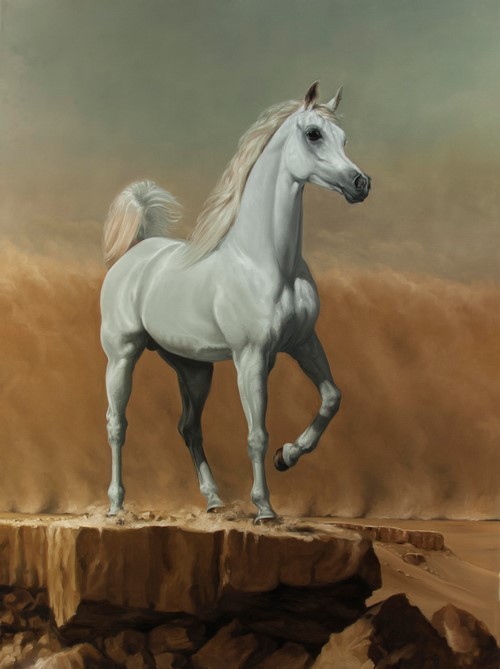On a beautiful late spring Sunday morning in peaceful Norfolk, I spoke to James Gillick, an artist that came to me by recommendation of the legendary Judith Forbis. James is hosting his first equine exhibition in London this summer – but talking to him, I very quickly came to realise that James is no ordinary Arabian horse artist. Instead, he has found the breed to be one that has fuelled his passion, recognising the amazing qualities of the Arabian horse that fascinate us all, and even suggesting that other breeds could learn a lot from the Arabian horse.
Typically, an artist feature will follow a standard pattern – history of the person, their introduction to the Arabian horse, and then key moments in their Arabian art history. Immediately, James went down a different path to the norm, and his approach was both refreshing and insightful. For while those of us that have been lucky enough to grow up with the Arabian breed know them to be deeply intelligent creatures that communicate freely with those that listen, it is rare for someone not as familiar with the breed to recognise that. And not only has James recognised the incredible attributes of the Arabian breed, he has almost set out his mission to be to change the equine world’s perspective, at large, of the Arabian being a “loco” animal.
“For me, the Arabian horse is the most phenomenal creature,” James tells me. “They are the most eloquent horses that I have ever seen – they are incredible communicators. They talk not just in their own family group but to people at large. The Arabian horse speaks so very clearly – and maybe that is why some people find them difficult to control, as they cannot listen.”
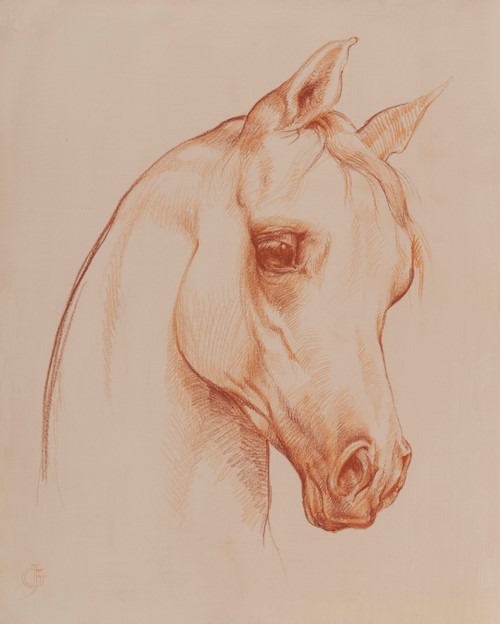 |
| Portrait of an Arabian. Sepia crayon. |
It is statements like this that immediately make you warm to James – and the further we go into our conversation, the more I impressed at not only his attitude to, and appreciation of, the Arabian breed, but also the way that he has devoted much of his forthcoming London exhibition to capturing the true essence of the Arabian breed.
“It was through Gerry Farrell, owner of the famous Sladmore Contemporary Gallery on Bruton Place in London, that I found myself in Kuwait last November,” James explains, as if aware that he needs to put an explanation around his insight into the breed. “I visited and immersed myself at Bait Al Arab and there, through Sheikha Sarah Fahad Al Sabah and Mohammed Jassim Al Marzouq of Ajmal Arabian Stud, I was able to experience the true personality of the Arabian horse. They laid on a wonderful few days, and I also met Judith Forbis. She made a huge impression on me. Through her work, particularly The Blue Book, Judith’s contribution to the Arabian breed is staggering. She has greatly added to our understanding of the bloodline, and also located the Arabian more centrally in the equine world.
“Indeed, the Ansata Stud lines are very evident at both Bait Al Arab and Ajmal Arabian Stud, in particular those of the late Ansata Hejazi (Ansata Halim Shah x Ansata Sudarra). I discovered that Ansata Hejazi is such a potent line, and the Ansata lines in general are the look that I have been capturing through my work.
 |
| Arabian Mare & Stallions. Oils on linen. |
Now seems an appropriate time to pause and look at James’ background, as it is one that helps understand the way that he sees horses. “I am a country bumpkin,” James jokes, having already established that he and his family are also from East Anglia. “I have been around horses for a long time, and I come from a painting background rather than a horsey one.
“Now, I come to horses from the angle of a painter. When you are involved day in, day out, with the assessment of Arabian horses, especially looking at conformation as you pick out their feet to ensure that they are sound, muck out their stables and so on, it makes you look at the equine differently. For me, painting an Arabian horse is almost an empirical study of the breed.
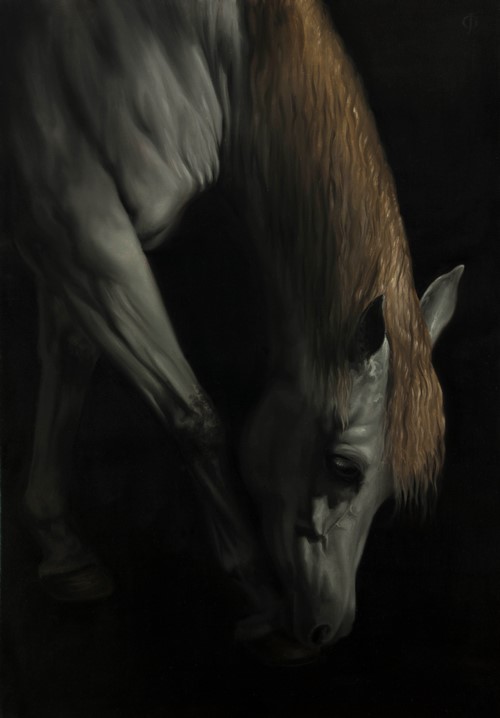 |
| Arabian scratching foot, ‘The Itch’. Oils on linen. |
Having been inspired by what James saw in Kuwait, he decided to concentrate the resulting exhibition on the way that the Arabian horse communicates, both with each other and with humans. “It is so unjust to label the Arabian breed, especially as ‘loco’”, James says. “They are exquisite, tender communicators.
“In many ways, it is easier to talk about what the Arabian horse is not, and as well as looking at the Arabian, I have also spent time looking at the thoroughbred and polo ponies. If you took a thoroughbred into an arena, took its head collar off and let it go, it would put its head down and then wander around. They are aloof and uninterested. However, slap it on its rump and it will turn into a speed machine!
“They are not great communicators – watch a thoroughbred stallion and mare together and you will see what I mean. However, you see so much more if you watch an Arabian stallion and mare together. There is an inordinate amount of communication between them and for this breed, communication is so important. The Arabian has an immense intelligence and ability to communicate.”
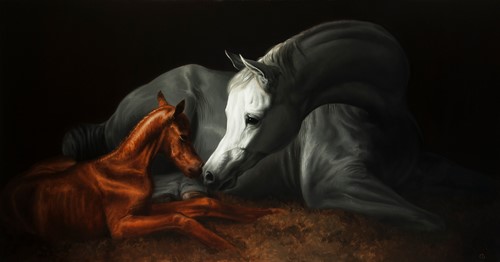 |
| Arabian mare lying with her new born foal. Oils on linen. |
James continues, looking at polo ponies: “They have terrific sporting intelligence, always wanting to do something active. They have a quiet and obedient eye, and they take instruction well. Again, look to the Arabian horse and they have the capacity and desire to communicate. To sit quietly in their company is such a different experience to being with thoroughbred or polo ponies.”
It is this communication that James is so keen to capture in his work, as is sharing it with the wider equine community. “The way that the Arabian horse communicates is quiet and strong. They have a great boldness, coupled with an intelligent mind. One of the key pieces in my forthcoming exhibit is called Young Arabian Stallion. It shows an Arabian stallion standing on a precipice, with a storm coming up behind him. The stallion is bold – you can see that he is strong – but he is also still.
“I have discovered that if you look at an Arabian horse in the show-ring, that is not a subject that will make a good painting. To see them naturally, at home, is how best to capture their true spirit.
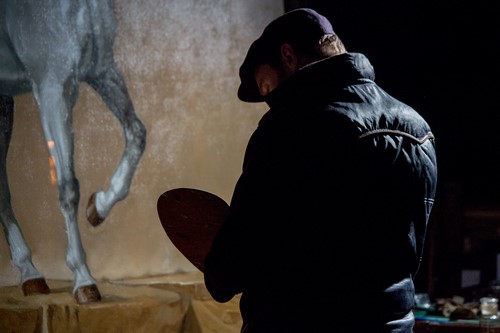 |
| James Gillick working. |
“I find that the Arabian horse is closely aligned with the Arab people that created them. They have the same qualities, the same strengths. Both the Arabian horse and the Arab people are dignified, and they never seem to let each other down. For me, the Arabian horse is a reflection of an entire culture.”
Indeed, like so many before us, James has fallen under the spell of the Arabian horse. However, he has also, almost instinctively, understood what makes the breed so special and the problems that Arabian breeders face in trying to ensure that their horses are taken seriously in the equine world at large.
“I will be honest, Samantha, I was struggling to get going with this exhibition,” James tells me. “I was first working on thoroughbreds and polo ponies and then I went to Kuwait. The Arabian horse lit a firework underneath me! I came back feeling absolutely inspired, and it is the Arabian horse that is the source, the heart, of the exhibition. In my time as an artist, I have done a lot of portrait work and so often, the person is inert. They just sit there. In equine times, they are like a thoroughbred. And yet the Arabian horse is ravishing, they turn it on all the time.
“I truly believe that there is a lot that the rest of the equine world can learn from the Arabian horse, and the people around it. If you look at the thoroughbreds once more, a thoroughbred stallion is deeply lonely. He is kept away from the mares, the mares from the youngstock. They are lovely creatures but they are lonely. If you look at the Arabian horse, you can see instinctively that they are happy horses. There is a lot that can be shared between owners of the different breeds, and a lot that can be learned from owners of Arabian horses.”
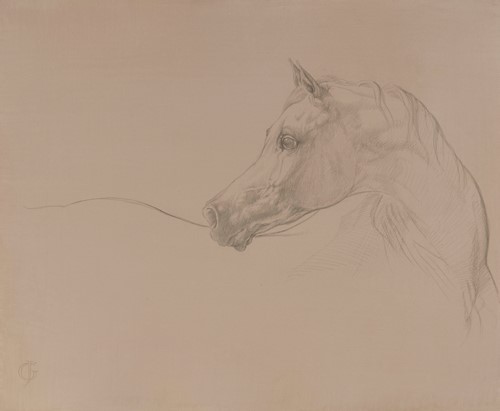 |
| Arabian turning to look left. Silverpoint |
James continues, talking about some of his work at the exhibition. “I have only painted the Arabian horse in a quiet pose,” he explains. “There is a real need to stop thinking of Arabian horses as lapdogs, as flighty things. There is a huge need to recalibrate them from the way that they are so often seen – as a pretty face on a useless animal – to what they actually are. There is way, way more to the Arabian horse than the common misconceptions of them and that is why, for me, it was very important for me to paint them quietly. For me to challenge what people see as the ‘loco’ Arabian.
“At the opening night of the exhibition, there will be a lot of top people there from the thoroughbred and polo worlds. This is my opportunity to stand there in front of them and share my knowledge on the true nature of the Arabian breed. For me that, is the greatest contribution that I can make – to help educate people and change their viewpoint on the Arabian horse.”
The exhibition, The Horse is James’ first exhibition purely of equines. While has been painting horses for a long time, this is the first time that he has invested so much in a more complete body of work.
“I realise that I am just on the periphery of the world of the Arabian horse but if I can add something to the breadth of understanding around the breed, then I will have done my job well. The Horse is just a small exhibition but it is very important for me to for people to see the Arabian breed as it truly is – a phenomenal creature, an exquisite communicator, and as an equine with deep understanding and intelligence.”
The Horse runs from 7-28 June at Sladmore Contemporary Gallery, London. Read more about the exhibition on our news pages.
—————————————————————————————————————————————————————————————-
A figurative painter, James Gillick lives and works in the quiet, beautiful backwater of rural Lincolnshire, England. He makes all his materials by hand using techniques that date back to the 17th century. His work ranges from the smallest of still life to game paintings and life size horse paintings. He also works on a wide variety of commissioned projects including portraiture and historic restoration.
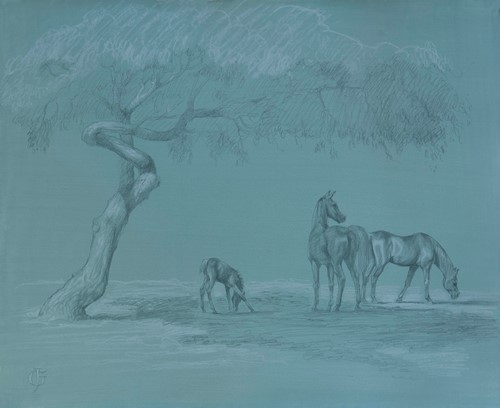 |
| Under the tree. Silverpoint with chalk highlights. |
Notable commissions include portraits of the Rt. Honourable Margaret Thatcher and His Holiness Pope John Paul II. The 400 or so paintings to have come from his brush in the last 20 years are to be found in private collections and places of worship across the globe.
Using ancient artistic techniques developed over many generations, James works in the tradition of every artist who has had a fascination with and respect for this subject, from the first to depict the horse in ancient caves, through great British masters such as George Stubbs, to the present day.
Mixing his paints from pure pigments gives his work an unmatched richness and luminosity. James prepares every element of his paintings by hand, using the finest materials to ensure their longevity.

